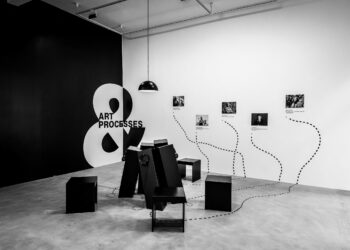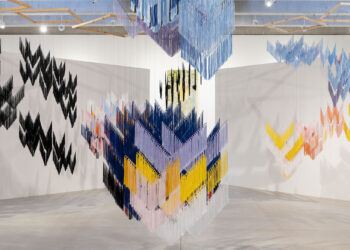ART AFRICA in conversation with Patrick Bongoy.
Born in the Democratic Republic of the Congo, Patrick Bongoy graduated from both the Institute of Fine Art and the Academy of Fine Art in Kinshasa. Bongoy currently lives and practices in Cape Town, South Africa, but continues to reference the socio-economic and political dialogue of his birth country.
ART AFRICA spoke to Bongoy about his experiences in both South Africa and the DRC, as well as his work for upcoming solo exhibition at EBONY Curated, ‘Where are we / Where are we Going?’.
 Patrick Bongoy, The Revenants II. Recycled rubber on fiberglass cast, 65 x 45 x 176 cm.
Patrick Bongoy, The Revenants II. Recycled rubber on fiberglass cast, 65 x 45 x 176 cm.
ART AFRICA: You were born, and spent your youth, in the Democratic Republic of the Congo (DRC) before moving to Cape Town in South Africa. Has the juxtaposition in culture between these two countries informed your practice in anyway?
PATRICK BONGOY: Yes, my practice has been informed by both the DRC and South Africa – issues related to industry, and the impact they have on society and the natural environment, are everywhere. The materials I use in my work were sourced and worked-with in the DRC. However, I can certainly find the same materials and issues wherever I go.
You have said that you create artworks which regards culture as a site of re-imagination and possibilities. Do these works relate solely to your birthplace, or has your time in South Africa had any impact on them, especially with regards to the current socio-economic and political unrest of this landscape?
My work is not related exclusively to where I am from, despite having been inspired by my culture and society. I recognise the instability and insecurity caused by the same socio-economic and political issues, here in South Africa. These issues have had, and continue to have, a huge impact across the African continent, and the world – arguably making what is at stake, even more important.
It’s easy to see what has been happening here in South Africa, both politically and economically, and how this leads to violent acts of xenophobia. Many South Africans consider outsiders as a threat to their survival – yet people have been fighting and killing each other every single day here? This devaluing of life, and of one another – due to poverty and the desperation that goes with it – is one of the issues I address in my work, both through my subject matter and the materials that I have consciously chosen to use.
Using the painstaking technique of cutting and weaving together strips of hessian into lifelike figures, you make reference to the numerous social concerns in the DRC. Can you please tell us a bit more about these concerns and how you came to the title of your upcoming solo show, ‘Where are we/Where are we Going’?
My country has been eroded in such a devastating way, that even the most simple and basic of human needs have become a challenge. The education system is collapsing, misery resonates over a huge amount of the population. There is no employment for both young and older people to develop and liberate themselves from this suffering and hopelessness.
These are the issues that reverberate in my conscience and I cannot get rid of the questions and reflections I have regarding the future of the DRC. What could change the direction of circumstances? What will give people a sense of purpose and direction in their lives, especially in such disempowering circumstances?
I recently returned home for the first time in years since I left for South Africa, and my return affirmed this sense of being haunted by such ‘where are we and where are we going’ questions. It seems quite clear that things are not improving.
 Patrick Bongoy, Covered I , 2017. Mixed media, found rubber, valve and nails, 38 x 30 cm.
Patrick Bongoy, Covered I , 2017. Mixed media, found rubber, valve and nails, 38 x 30 cm.
You refer to these numerous social concerns as being the status quo in the DRC, and mention the dynamic between the powerful and the powerless. How have you captured this dynamic in your body of work, and which materials have you chosen to use to most effectively demonstrate this?
When you see original rubber tyre tubes discarded from industrial vehicles, it is reminiscent of a variety of things. Personally, the tyre tube or wheel reminds me of something that rolls – a motion associated with ‘evolution’ due to its rotating effect. I am also made aware of pollution and the way industries – like mining and manufacture, import and export trade – have all been producing a huge quantity of rubber for different purposes. What do they do with that waste? The processes of industrial movement and transportation also affects the ozone layer by the gases generated.
For me, these materials demonstrate a dynamic between life, or growth, and destruction. Also, because of instability in the DRC and peoples’ need to keep moving in search of a ‘promised land’ or better life – they have become victims of both displacement and the trauma and difficulties caused along the way. Women and children are the most vulnerable, and it is these stories that I have chosen to portray in much of my work.
There is also the less visible trauma and transformation of being on such a long journey into the unknown, where the imagined destination seldom meets expectations and hopes. We are changed on a deeper level because of what we have been through and where we are now, who we have (had to) become.
In your artist statement, you make mention of the Evangelical Church and the role it plays in the current socio-economic and political landscape of the DRC. Could you please tell us more about the impact Evangelism has on communities – including how you have chosen to portray this in ‘Where are we/Where are we going’?
For centuries, the church has been playing a major part in the country’s politics – something that has continued up until today. I’m making reference to one church in specific, which is commonly referred to as the ‘Wake Church’. Here, evangelical missions capitalise on my people’s fears and desperation. These, mostly corrupt, organisations are eating away at the population of my country whilst spinning a series of lies that revolve around prosperity and healing. This is something that we need to talk about – especially how the influence of the church has trapped, robbed and blinded numerous people.
‘Where are we/ Where are we Going?’ opens at EBONY Curated in Cape Town on the 26th April, and runs until the 26th May.



